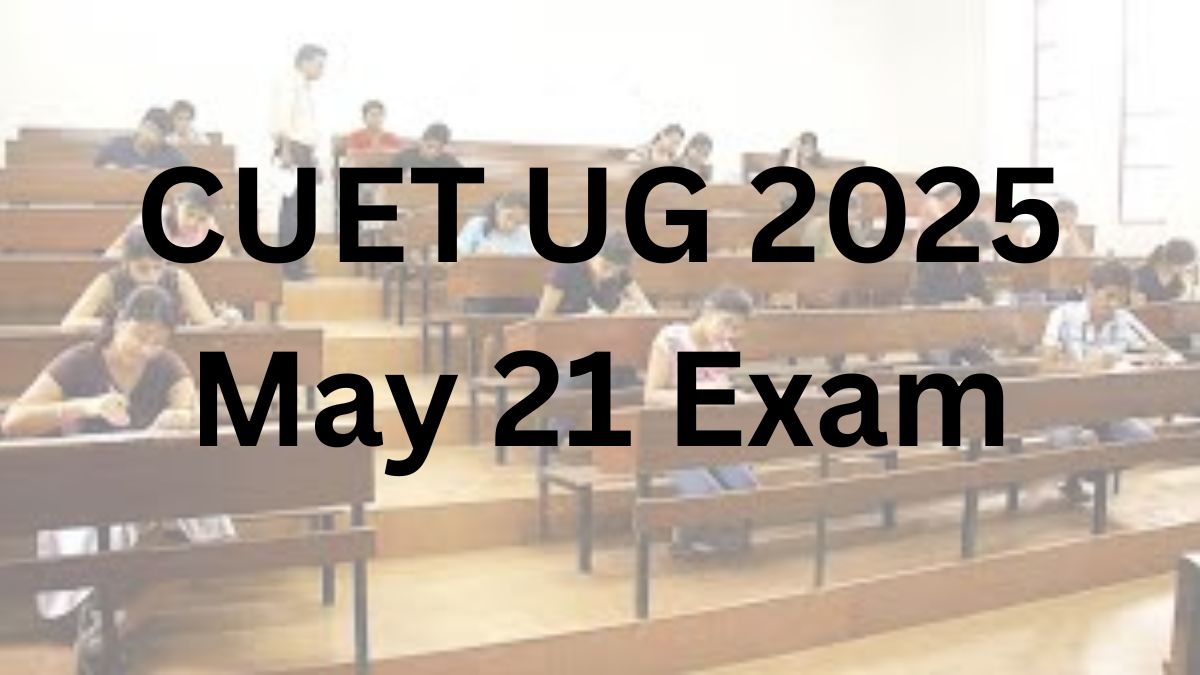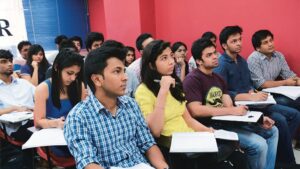The CUET UG 2025 exam has been successfully conducted today, May 21, at various centers across India and some international cities. The exam is being held in two shifts—Shift 1 took place from 9:00 AM to 12:00 PM, while Shift 2 is happening from 3:00 PM to 6:00 PM. Students who appeared for the exams can now check the subject-wise analysis and difficulty level in the article below.
The National Testing Agency (NTA), CUET 2025, is conducting the CUET UG Exams between May 13 and June 03, 2025 in a computer-based test. This year, over 200 universities in India will use CUET UG scores, including all central universities, for admissions. The exam is conducted for 23 subjects related to different courses, 13 languages, and a General Test. Students can choose the subjects based on the course they want to study.
CUET UG 2025 May 21 Exam Analysis
The CUET UG 2025 Shift 1 exam, conducted on May 21, went off smoothly in all the centres without any interruptions. According to student responses and expert opinions, the overall level of difficulty of the paper was easy to moderate. Though the paper was a bit long, students were able to attempt most questions with effective time management.
The General Aptitude Test (GAT) part was reasoning and general knowledge-based, and the questions asked were typical and anticipated. The English paper was medium in level and consisted of comprehension passages, vocabulary questions, and grammar. Mathematics and allied subjects examined fundamental concepts for CUET preparation. Though the questions were fewer in number, they were significant in order to test conceptual clarity.
CUET UG 2025 May 21 Exam Difficulty Level
The difficulty level of the May 21 Physics exam was termed as moderate to easy, while of the English subject was difficult. Check the table below:
|
CUET UG 2025 May 21 Exam Difficulty Level
|
|
| CUET 2025 Subject |
Difficulty Level
|
| Physics |
Moderate to Easy
|
| English | Difficult |
| Chemistry | Moderate |
CUET UG 2025 May 21 GAT Logical Reasoning MBT Questions with Answers
Q1. Statements:
Some books are magazines.
Some magazines are novels.
Conclusions:
(I) Some books are novels.
(II) Some novels are magazines
(a) Only (I) follows
(b) Only (II) follows
(c) Both (I) and (II) follow
(d) Neither (I) nor (II) follows
Q2. In a certain code language ‘nik ka pa’ means ‘who are you’, ‘ka na ta da’ means ‘you may come here’ and ‘na ta sa’ means ‘come and go’, what does ‘nik’ mean in that code language?
(a) who
(b) are
(c) who or are
(d) Data inadequate
Q3. Of the five villages P, Q, R, S and T situated close to each other, P is to the West of Q, R is to the South of P, T is to the North of Q and S is to the East of T. Then, R is in which direction with respect to S?
(a) North-West
(b) South-East
(c) South-West
(d) Data inadequate
Q4. 6, 18, 3, 21, 7, 56,?
(a) 8
(b) 9
(c) 63
(d) 64
Q5. Pointing to a man, Mohit said, “He is the son of my wife’s maternal’s grandfather’s only child”. How is the man related to Mohit ?
(a) Brother
(b) Brother-in-law
(c) Father
(d) Son
CUET UG 2025 May 21 GAT Logical Reasoning MBT Questions with Answers
Direction (Q1-Q5): Read the passage below and answer the question:
The Goods and Services Tax (GST) represents a significant reform in India’s indirect taxation system. Introduced nationwide from July 1st, 2017, its primary aim was to replace a multitude of central and state-level indirect taxes, such as excise duty, service tax, and VAT. The core objectives behind this transition included mitigating the cascading effect of taxes and creating a unified national market. GST is designed as a comprehensive tax levied on the supply of goods and services, with the tax burden ultimately borne by the final consumer. The system operates under a dual structure, involving both the central government (CGST) and state governments (SGST) concurrently. For transactions occurring between different states, an Integrated GST (IGST) mechanism is in place. The framework is based on the principle of a destination-based consumption tax and incorporates an Input Tax Credit (ITC) mechanism. This reform intends to simplify the tax structure and enhance efficiency in the economy.
Q1. The GST Council governs GST in India and is chaired by the Union Finance Minister. Besides the Union Finance Minister, who are the other key members typically included in the GST Council?
(a) Chief Justices of the Supreme Court and High Courts
(b) State Finance Ministers or their nominated representatives
(c) Chairpersons of Public Sector Banks
(d) Chief Ministers of all States
S1. Ans. (b)
Sol. The GST Council, which governs GST in India, is a joint forum of the Centre and States. Its standard composition includes the Union Finance Minister (Chairperson) and the State Finance Ministers or their nominated representatives from each state and union territory. This structure ensures representation from both the central and state governments in decision-making processes regarding GST.
Q2. GST is a comprehensive tax levied on the supply of goods and services and implemented across India. Based on the general application of GST in India, which of the following is a primary factor determining if a business is required to register under GST?
(a) The number of branches the business operates
(b) The business’s annual aggregate turnover exceeding a specified threshold
(c) Whether the business is owned by an individual or a company
(d) The educational qualification of the business owner
S2. Ans. (b)
Sol. A fundamental aspect of GST implementation is the requirement for businesses to register based on their annual aggregate turnover. If a business’s turnover exceeds the threshold prescribed by the government (which varies depending on the nature of supply and location), it is mandatory for them to register under GST. This is a standard feature of the tax not explicitly detailed in the provided text but relates directly to its broad application.
Q3. The GST aims to eliminate the cascading effect of taxes and create a single national market. The Input Tax Credit (ITC) mechanism is also mentioned as part of the GST framework. How does the seamless flow of ITC, enabled by GST, primarily benefit businesses?
(a) By increasing the final price of goods and services
(b) By allowing businesses to pay taxes only on the value added at each stage of the supply chain
(c) By exempting businesses from paying any taxes on their outputs
(d) By making compliance procedures more complex
S3. Ans. (b)
Sol. The final consumer bears the tax and that businesses are entitled to get Input Tax Credit (ITC) on their inputs (a tax on value addition only). The seamless flow of ITC is a key benefit of GST that allows businesses to claim credit for taxes paid on their purchases (inputs) and set it off against the tax payable on their sales (outputs). This ensures that tax is effectively levied only on the ‘value added’ at each stage of the supply chain, thus eliminating the cascading effect of taxes.
Q4. GST as a dual system involving both central and state components (CGST and SGST) levied concurrently on intra-state transactions. For interstate transactions, IGST is levied and collected by the center. Which of the following best describes the purpose of the Integrated Goods and Services Tax (IGST)?
(a) To collect tax on imports into India only
(b) To ensure a seamless flow of credit across states for interstate supplies
(c) To replace income tax on businesses involved in interstate trade
(d) To levy tax only on services supplied between states
S4. Ans. (b)
Sol. The IGST mechanism has been designed to ensure seamless goods flow from one state to another. IGST is levied on interstate supplies of goods and services. A primary purpose of IGST is to facilitate the flow of Input Tax Credit across state borders, ensuring that businesses can utilize the credit of CGST, SGST, and IGST paid on their interstate purchases to set off against their IGST liability on interstate sales, thereby maintaining the chain of ITC across the country.
Q5. GST is a destination-based consumption tax. Based on this principle, where is the revenue from an intra-state GST transaction (CGST and SGST) primarily allocated?
(a) To the state from where the goods are dispatched or services originate
(b) Equally between the state of origin and the state of destination
(c) To the state where the final consumption of the goods or services takes place
(d) To the Central Government only
S5. Ans. (c)
Sol. The GST as a destination-based consumption tax, stating that it implies that all SGST collected will ordinarily occur to the state where the consumer of goods and services sold resides. This means that the revenue from GST, both the state component (SGST) and a portion of the central component (CGST), for intra-state sales accrues to the state where the final consumption occurs, not the state where the goods were produced or services originated.



 Best CUET Coaching in Delhi - Factors De...
Best CUET Coaching in Delhi - Factors De...
 Best CUET Coaching in Noida - Get Top 5 ...
Best CUET Coaching in Noida - Get Top 5 ...
 CUET PG Previous Year Question Papers wi...
CUET PG Previous Year Question Papers wi...







